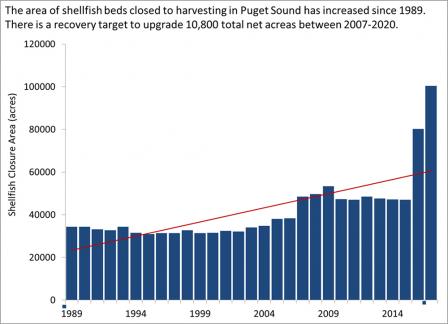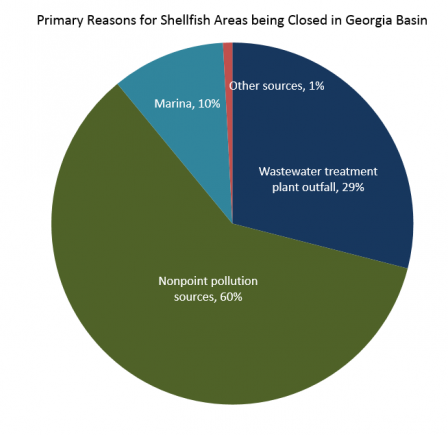Shellfish Harvesting
Summary
Improving
Between 2007 and 2017, over 6,700 acres of previously closed shellfish beds in Puget Sound have been upgraded or re-opened due to improvements in water quality.
However, there has also been an overall increase in the number of acres of shellfish beds that are prohibited or restricted from harvesting. This increasing trend is due partly to increased water quality monitoring, changes in classifying closed areas, and methods of mapping beach closures.
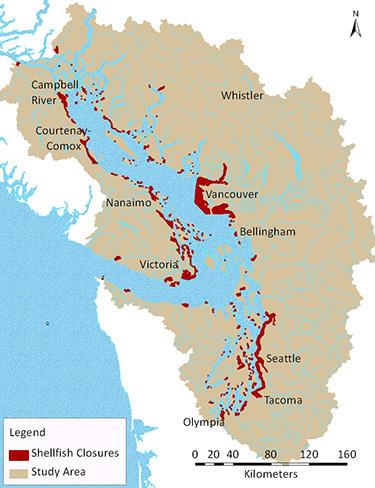 Map of shellfish closure areas in the Salish Sea (as of 2014).
Map of shellfish closure areas in the Salish Sea (as of 2014).
See also Washington's shellfish closure maps for Puget Sound.Exit
Updated March 2018
Shellfish are an important part of the economy, lifestyle and heritage of this region. The Salish Sea is home to an abundance of clams, mussels, and oysters and other bivalve shellfish. Because they feed by filtering the water that washes over the shellfish bed, they can accumulate disease-causing bacteria and viruses that are harmful to people.
The shellfish harvesting indicator reflects access to safe shellfish resources in the Salish Sea ecosystem. Shellfish beaches are assigned a classification that determines whether shellfish in that area are safe to eat. The classification is based on the results of a local sanitary survey and water quality monitoring.
If monitoring shows poor water quality, or if the sanitary survey identifies potential impacts to water quality - such as being located too close to a wastewater treatment outfall - then the shellfish beach may be closed to harvesting.
- About shellfish beach classifications
Shellfish beach classifications are similar in both the U.S. and Canada. Commercial growing areas and recreational growing areas have slightly different classification names, but the standards are similar. Commercial harvest is not allowed in areas that are not classified.
Approved - This classification applies to areas that are safe for harvesting based on the sanitary survey. This classification authorizes commercial shellfish harvest for direct marketing.
Conditionally Approved - This classification means an area is safe for harvesting except during certain periods. The length of the closed periods is based on water sample data that show how long it takes for safe harvesting conditions to return to that area.
Restricted - When the sanitary survey shows a limited degree of pollution, including from non-human sources, the area may be classified as restricted. Shellfish harvested commercially from restricted growing areas cannot be marketed directly. They must be transplanted to approved growing areas for a specified amount of time, allowing shellfish to naturally cleanse themselves of contaminants before they are harvested for market.
Prohibited – This classification applies to growing areas near sewage treatment plant and industrial outfalls, marinas, and other pollution sources. Commercial shellfish harvests are not allowed from prohibited areas.
Marine water quality samples are collected throughout the year to support shellfish bed classifications. Shoreline surveys are conducted less frequently, but each year dozens of shellfish growing areas are surveyed to evaluate all potential sources of pollution that may impact water quality in that area.
What's happening?
In 2017, over 265,000 acres (or about 1075 km2) of shellfish beds were closed to harvesting in the Georgia Basin, and about 100,000 acres (or about 400 km2) were closed in Puget Sound. These values include all areas that are prohibited, restricted, or have only conditional approval for commercial harvest.
- Learn more about what's happening
Georgia Basin
Since 1989 in the Georgia Basin, the area of tidal lands closed to shellfish harvesting has steadily increased by 45% (see chart below). However, this is partly due to increased monitoring efforts and refinements in designating closure areas.
Click chart to view larger image.
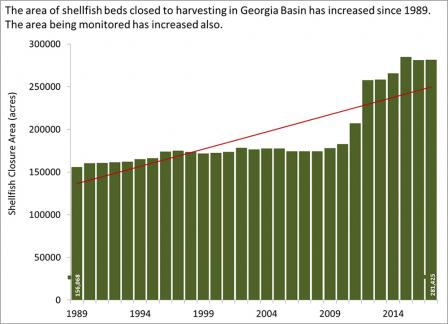
Puget Sound
Since 1989 in Puget Sound, the area of tidal lands closed to shellfish harvesting has almost tripled (see chart below). However, since 2007, the number of acres of shellfish beds upgraded in classification has also increased. While these upgrades may not all result in beach openings, they reflect efforts toward recovery.
Why is it important?
This region is one of the largest producers of shellfish in North America. Areas that are closed to shellfish harvesting can impact the livelihood of growers, workers, supermarkets, restaurants, hotels, and sales of recreational equipment, among other economic losses. Shellfish closures also impact First Nation and tribal shellfish harvesting rights, which have been part of their traditions and economies for thousands of years.
- Learn more about why it's important
Recreation is another important economic factor associated with shellfish harvesting. In 2005, the Washington Department of Fish and Wildlife collected nearly $1.5 million in licensing fees for harvest of shellfish and seaweed.
Shellfish also help improve water clarity by filtering the water, provide food for animals higher in the food webs, and create space to allow more light for eelgrass to grow - which provides a crucial nursery for many fish and other marine animals.
Why is it happening?
The primary sources of pollution that lead to closure of shellfish harvesting areas are polluted runoff from urban areas and farms, and uncontrolled sources of sewage and septic wastes.
Urbanization creates more roads and other impervious surfaces that can become "super highways" for oil, grease, chemicals, fertilizers, pet waste, sediment and other pollution when it rains. Likewise, manure and agricultural chemicals that are not properly treated or controlled by farms can end up in our waterways and impact shellfish growing areas.
Sewage from malfunctioning or aging treatment plants and failure of home septic systems can release human waste and other dangerous bacteria and pathogens into shellfish-growing areas. Some marinas and boaters also release untreated sewage to water.
- Learn more about why it's happening
Puget Sound
The chart below shows why shellfish beaches in Puget Sound were classified as prohibited for harvesting in 2014:
- 63% were near wastewater treatment plant outfalls. Note: Most prohibited areas around wastewater outfalls are based on the potential for pollution and not actual water quality.
- 26% were impacted or potentially impacted by nonpoint pollution sources such as poorly functioning on-site sewage systems (septic), farms, wildlife, and other potential sources.
- 8% were near marinas. Note: Prohibited areas around marinas are based on the number of boats and their potential to contribute pollution, not actual water quality.
- 3% were prohibited based on other sources.
Click chart to view larger image.
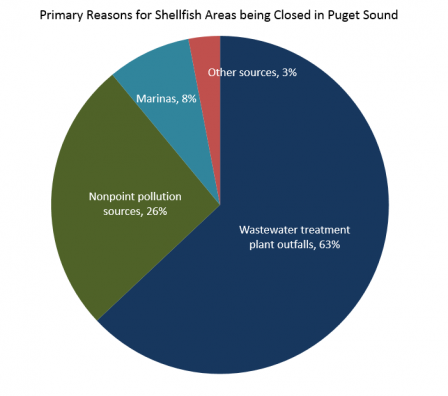
Georgia Basin
In contrast, the primary reason for the closure of shellfish beds in Georgia Basin during the same period was nonpoint pollution such as urban and agricultural runoff and seepage from septic fields, which contributed to 60% of the shellfish closure areas. Impacts from wastewater treatment plant outfalls contributed to 29% of the closures.
What's being done?
Government agencies are working with communities to create shellfish protection districts and develop strategies for both preventing and responding to harvest closures. Tribes in Washington and First Nations in British Columbia are leading community partnerships that target specific pollution sources. In both the U.S. and Canada, many shellfish growers belong to trade associations which foster environmental responsibility and effective stewardship of shellfish growing areas.
- Success stories: Drayton Harbor, Samish Bay, and Indian Arm
Drayton Harbor
Blaine, WashingtonThe downgrade of Drayton’s shellfish beds in 1997 sparked a community-wide effort to reduce pollution and clean up the harbor. Two decades later, the community efforts paid off. In November 2016, 810 acres of shellfish beds were reclassified as “approved” for harvest. Year-round harvests resumed for the first time in 22 years.
Action in Drayton Harbor required a multi-faceted approach. A key first step was establishing a Pollution Identification and Correction—or PIC—program. In Drayton, investigators with the PIC program located hot spots showing a large concentration of fecal bacteria. They then worked upstream to identify potential sources. Clean-up targeted two major pollution sources: human waste and animal waste.
To address human waste, broken sewer lines and failing septic systems were repaired. Pump-out facilities were relocated to reduce the risk of spills from boats. A new sewage treatment plant was built and stormwater was separated from sewage collection.
To address waste from agriculture, the local conservation district helped farmers voluntarily improve their manure-handling practices. This included an end to the practice of applying liquid manure during shellfish harvesting season. New pet waste stations were installed in parks to prevent pet waste from washing into the harbor. Fish processors improved their management practices and reduced effluent.
Restoration of Drayton Harbor succeeded thanks to an intensive community effort that convened 30 partners to find and address pollution sources. Partners included key state and federal agencies, local government, conservation districts, and community groups. Partners invested more than $2.8 million to restore water quality and dedicated over 38,000 volunteer hours.
Drayton Harbor is a living success story, but that doesn’t mean the work is done. To sustain the benefits of our recovery investments, the community has to continue to address ongoing needs. National Estuary Program funding leveraged local expertise and capital investment. That funding made it possible to develop a local, self-sustaining approach to reduce fecal contamination by helping individual property owners pay for repairs. This funding also helped to create systems for pollution monitoring and community engagement. Continued support is needed, especially in areas where pollution risk is the greatest or where pollution sources are still unknown.
Samish Bay
Edison, WashingtonIn 2011, about 4,000 acres of the Samish Bay shellfish growing area was downgraded due to high bacteria levels in the Samish River. The Puget Sound Partnership responded by teaming with the Clean Samish Initiative and others to develop a ten point action plan to direct cleanup in the watershed. Actions included increased inspections, more education of dairy and other landowners, assistance to farmers for livestock fencing and to landowners for portable restrooms for recreational users.
Their goal is to control local sources of pollution and re-open these valuable harvesting areas.
Indian Arm
Vancouver, B.C.All of Burrard Inlet, including Indian Arm and Port Moody Arm, have been prohibited to direct shellfish harvesting since the 1980s due to the intensity of urban and industrial activity.
In May 2016, however, area 28-13 toward the northern tip of Indian Arm Provincial Park near Granite Falls was opened to limited harvest for food, social, and ceremonial purposes by Tseil-Waututh Nation.
This followed a 2006 request to examine this remote portion of Indian Arm on its own merit, and 10 years of collaboration with Canadian federal departments, including Environment and Climate Change Canada, Department of Fisheries and Oceans, the Canadian Food Inspection Agency, and Health Canada.
Cooperative efforts included interviews with elders for historic knowledge on harvest areas, marine water quality monitoring for fecal contamination, biotoxin testing, ongoing shoreline evaluation to assess actual and potential sources of fecal contamination, a health risk assessment, and the development of a community harvest plan.
The first shellfish harvest in over 30 years took place in October 2016.
- Learn more about what's being done
Puget Sound
The Puget Sound Partnership has set a target to upgrade 10,800 total net acres (44 square kilometres) in Puget Sound between 2007 and 2020.
As of 2016, the area of upgraded shellfish beaches in Puget Sound had increased by 4,803 net acres (see chart below).
Click chart to view larger image.
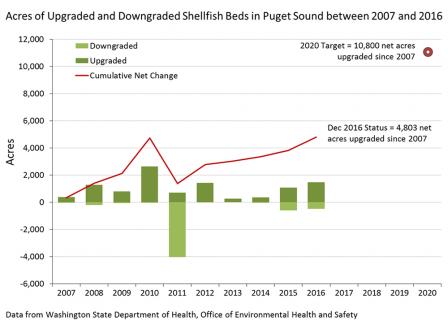
The Washington Dept. of Health (under the U.S. National Shellfish Sanitation Program) also conducts sanitary surveys in shellfish growing areas and closes harvest areas when there is a threat to public health. These surveys include a shoreline evaluation to identify pollution sources that may impact water quality, sampling to determine bacteria levels in the water, weather conditions, tides and other factors that may affect the distribution of pollution in the area.
Georgia Basin
In the Georgia Basin, the Canadian Shellfish Sanitation Program mandates a partnership in which Fisheries and Oceans Canada opens and closes shellfish areas on the recommendation of either Environment Canada or the Canadian Food Inspection Agency (CFIA). CFIA maintains the biotoxin surveillance program and monitors the processing of edible shellfish for compliance with federal standards.
Environment Canada monitors the level of fecal contamination in shellfish growing areas, identifies nearby pollution sources that could impact these areas, and recommends growing water classifications for approval by the Pacific Region Interdepartmental Shellfish Committee.
In 2012, new Wastewater System Effluent Regulations came into force in Canada that reduced pollution from wastewater treatment plants and led to improved water quality to help reduce shellfish beach closures. The new regulations required upgrades to secondary wastewater treatment at two facilities in MetroVancouver, including the Lions Gate Wastewater Treatment Plant in North Vancouver, and the Iona Island Wastewater Treatment Plant in Richmond. The cost of upgrades is estimated at $1.4 billion. The governments of Canada, British Columbia, and Capital Regional District also recently announced a new wastewater treatment system for Greater Victoria with an estimated total capital cost of $782.7 million.
Five things you can do to help
- Scoop your pet's poop. Pet waste is full of bacteria that can get washed into waterways and make people sick if they eat contaminated shellfish. Bag it and place it in the trash.
- If you're a boater, manage your sewage wastes properly. Do not discharge treated or untreated sewage into our waterways. Many marinas provide sewage pumpout as a free or low cost service.
- If your home or business uses a septic system, take time to learn how your system works and keep it properly maintained. Ask for maintenance advice from your local health agency.
- Use techniques such as natural landscaping, rain gardens, rain barrels, green roofs and permeable paving to help reduce the need for chemical fertilizers and reduce runoff into ditches and storm drains.
- Do your part to dispose of unused medicine and chemicals properly. Never dump into household toilets and sinks or outside where they can get into ditches or storm drains. See if your community has a household hazardous waste drop-off facility that will take your old or unused chemicals.
Learn more about this topic
The following links exit the site Exit
- Washington Dept. of Health - Shellfish
- Environment and Climate Change Canada Marine Water Quality Monitoring Program
- U.S. Food and Drug Administration National Shellfish Sanitation Program
- Canadian Shellfish Sanitation Program
- Puget Sound Partnership Vital Signs - Shellfish
- MetroVancouver Integrated Liquid Waste and Resource Management Plan
- Capital Regional District Wastewater Treatment Project (Vancouver Island)
Scientific references
The following links exit the site Exit
- US Food and Drug Administration. 2011. National Shellfish Sanitation Program. Accessed April 25, 2012.
- Canadian Food Inspection Agency. 2011. Canadian Shellfish Sanitation Program. Accessed April 25, 2012.

